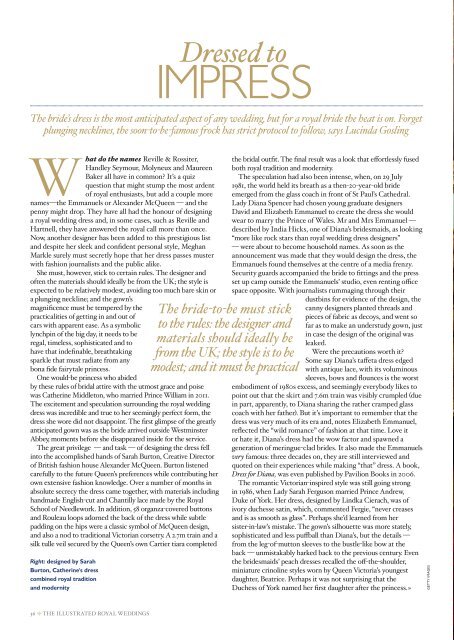You also want an ePaper? Increase the reach of your titles
YUMPU automatically turns print PDFs into web optimized ePapers that Google loves.
Dressed to<br />
IMPRESS<br />
The bride’s dress is the most anticipated aspect of any wedding, but for a royal bride the heat is on. Forget<br />
plunging necklines, the soon-to-be-famous frock has strict protocol to follow, says Lucinda Gosling<br />
What do the names Reville & Rossiter,<br />
H<strong>and</strong>ley Seymour, Molyneux <strong>and</strong> Maureen<br />
Baker all have in common? It’s a quiz<br />
question that might stump the most ardent<br />
of royal enthusiasts, but add a couple more<br />
names—the Emmanuels or Alex<strong>and</strong>er McQueen — <strong>and</strong> the<br />
penny might drop. They have all had the honour of designing<br />
a royal wedding dress <strong>and</strong>, in some cases, such as Reville <strong>and</strong><br />
Hartnell, they have answered the royal call more than once.<br />
Now, another designer has been added to this prestigious list<br />
<strong>and</strong> despite her sleek <strong>and</strong> confident personal style, <strong>Meghan</strong><br />
<strong>Markle</strong> surely must secretly hope that her dress passes muster<br />
with fashion journalists <strong>and</strong> the public alike.<br />
She must, however, stick to certain rules. The designer <strong>and</strong><br />
often the materials should ideally be from the UK; the style is<br />
expected to be relatively modest, avoiding too much bare skin or<br />
a plunging neckline; <strong>and</strong> the gown’s<br />
magnificence must be tempered by the<br />
practicalities of getting in <strong>and</strong> out of<br />
cars with apparent ease. As a symbolic<br />
lynchpin of the big day, it needs to be<br />
regal, timeless, sophisticated <strong>and</strong> to<br />
have that indefinable, breathtaking<br />
sparkle that must radiate from any<br />
bona fide fairytale princess.<br />
One would-be princess who abided<br />
by these rules of bridal attire with the utmost grace <strong>and</strong> poise<br />
was Catherine Middleton, who married <strong>Prince</strong> William in 2011.<br />
The excitement <strong>and</strong> speculation surrounding the royal wedding<br />
dress was incredible <strong>and</strong> true to her seemingly perfect form, the<br />
dress she wore did not disappoint. The first glimpse of the greatly<br />
anticipated gown was as the bride arrived outside Westminster<br />
Abbey, moments before she disappeared inside for the service.<br />
The great privilege — <strong>and</strong> task — of designing the dress fell<br />
into the accomplished h<strong>and</strong>s of Sarah Burton, Creative Director<br />
of British fashion house Alex<strong>and</strong>er McQueen. Burton listened<br />
carefully to the future Queen’s preferences while contributing her<br />
own extensive fashion knowledge. Over a number of months in<br />
absolute secrecy the dress came together, with materials including<br />
h<strong>and</strong>made English-cut <strong>and</strong> Chantilly lace made by the <strong>Royal</strong><br />
School of Needlework. In addition, 58 organza-covered buttons<br />
<strong>and</strong> Rouleau loops adorned the back of the dress while subtle<br />
padding on the hips were a classic symbol of McQueen design,<br />
<strong>and</strong> also a nod to traditional Victorian corsetry. A 2.7m train <strong>and</strong> a<br />
silk tulle veil secured by the Queen’s own Cartier tiara completed<br />
Right: designed by Sarah<br />
Burton, Catherine's dress<br />
combined royal tradition<br />
<strong>and</strong> modernity<br />
The bride-to-be must stick<br />
to the rules: the designer <strong>and</strong><br />
materials should ideally be<br />
from the UK; the style is to be<br />
modest; <strong>and</strong> it must be practical<br />
the bridal outfit. The final result was a look that effortlessly fused<br />
both royal tradition <strong>and</strong> modernity.<br />
The speculation had also been intense, when, on 29 July<br />
1981, the world held its breath as a then-20-year-old bride<br />
emerged from the glass coach in front of St Paul’s Cathedral.<br />
Lady Diana Spencer had chosen young graduate designers<br />
David <strong>and</strong> Elizabeth Emmanuel to create the dress she would<br />
wear to marry the <strong>Prince</strong> of Wales. Mr <strong>and</strong> Mrs Emmanuel —<br />
described by India Hicks, one of Diana’s bridesmaids, as looking<br />
“more like rock stars than royal wedding dress designers”<br />
— were about to become household names. As soon as the<br />
announcement was made that they would design the dress, the<br />
Emmanuels found themselves at the centre of a media frenzy.<br />
Security guards accompanied the bride to fittings <strong>and</strong> the press<br />
set up camp outside the Emmanuels’ studio, even renting offce<br />
space opposite. With journalists rummaging through their<br />
dustbins for evidence of the design, the<br />
canny designers planted threads <strong>and</strong><br />
pieces of fabric as decoys, <strong>and</strong> went so<br />
far as to make an understudy gown, just<br />
in case the design of the original was<br />
leaked.<br />
Were the precautions worth it?<br />
Some say Diana’s taffeta dress edged<br />
with antique lace, with its voluminous<br />
sleeves, bows <strong>and</strong> flounces is the worst<br />
embodiment of 1980s excess, <strong>and</strong> seemingly everybody likes to<br />
point out that the skirt <strong>and</strong> 7.6m train was visibly crumpled (due<br />
in part, apparently, to Diana sharing the rather cramped glass<br />
coach with her father). But it’s important to remember that the<br />
dress was very much of its era <strong>and</strong>, notes Elizabeth Emmanuel,<br />
reflected the “wild romance” of fashion at that time. Love it<br />
or hate it, Diana’s dress had the wow factor <strong>and</strong> spawned a<br />
generation of meringue-clad brides. It also made the Emmanuels<br />
very famous: three decades on, they are still interviewed <strong>and</strong><br />
quoted on their experiences while making “that” dress. A book,<br />
Dress for Diana, was even published by Pavilion Books in 2006.<br />
The romantic Victorian-inspired style was still going strong<br />
in 1986, when Lady Sarah Ferguson married <strong>Prince</strong> Andrew,<br />
Duke of York. Her dress, designed by Lindka Cierach, was of<br />
ivory duchesse satin, which, commented Fergie, “never creases<br />
<strong>and</strong> is as smooth as glass”. Perhaps she’d learned from her<br />
sister-in-law’s mistake. The gown’s silhouette was more stately,<br />
sophisticated <strong>and</strong> less puffball than Diana’s, but the details —<br />
from the leg-of-mutton sleeves to the bustle-like bow at the<br />
back — unmistakably harked back to the previous century. Even<br />
the bridesmaids’ peach dresses recalled the off-the-shoulder,<br />
miniature crinoline styles worn by Queen Victoria’s youngest<br />
daughter, Beatrice. Perhaps it was not surprising that the<br />
Duchess of York named her first daughter after the princess. »<br />
GETTY IMAGES<br />
36 THE ILLUSTRATED ROYAL WEDDINGS<br />
THE ILLUSTRATED ROYAL WEDDINGS 29





